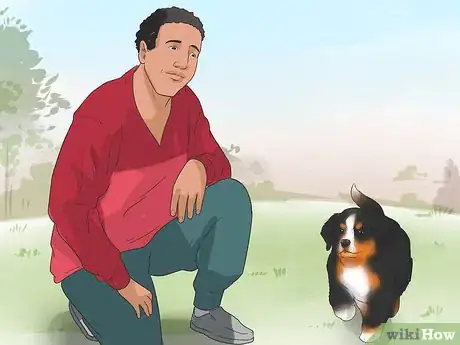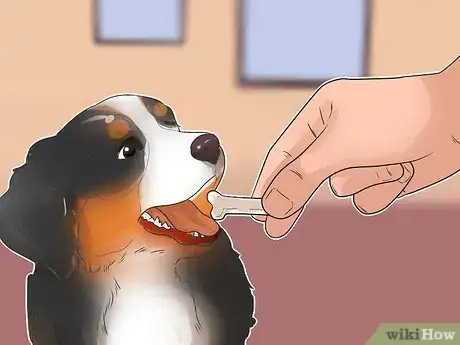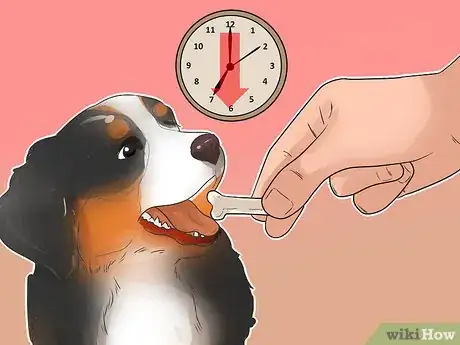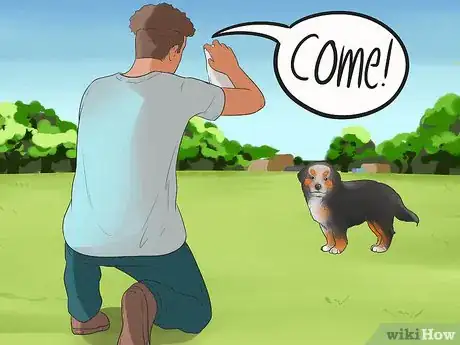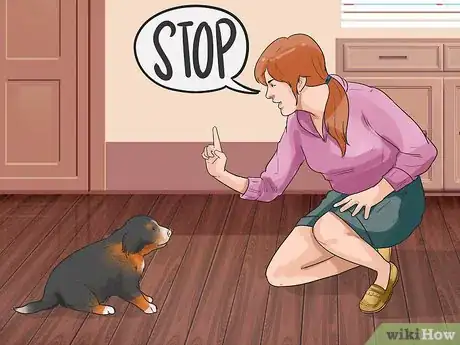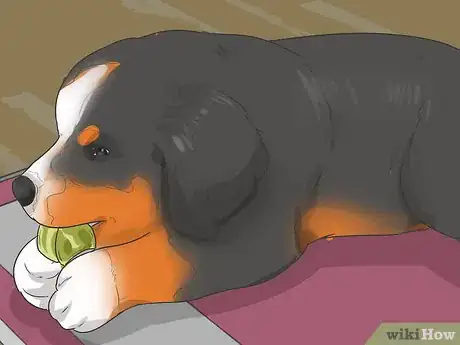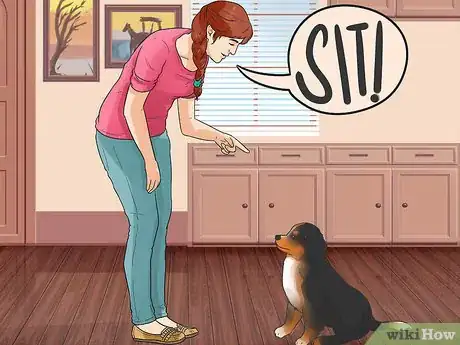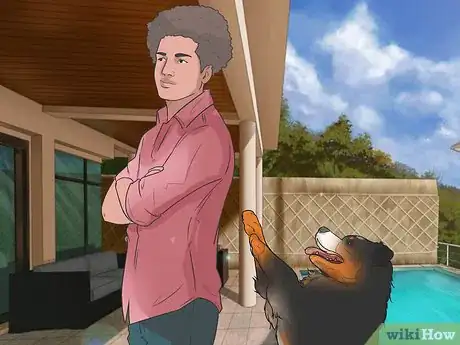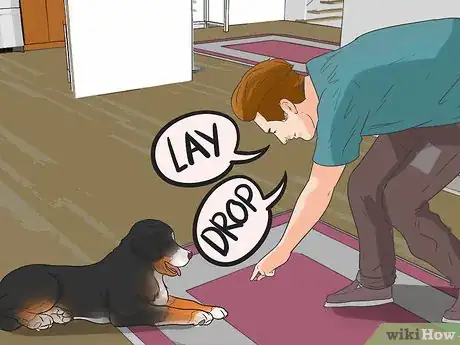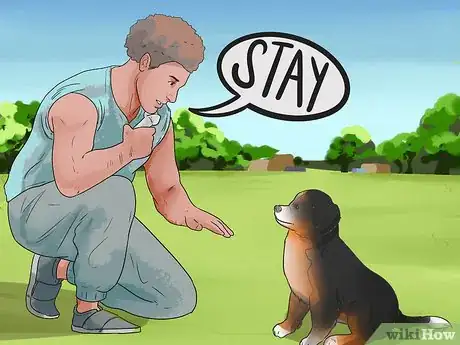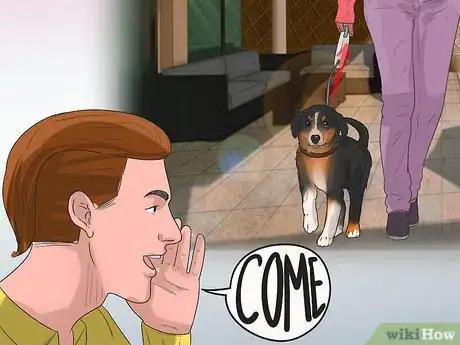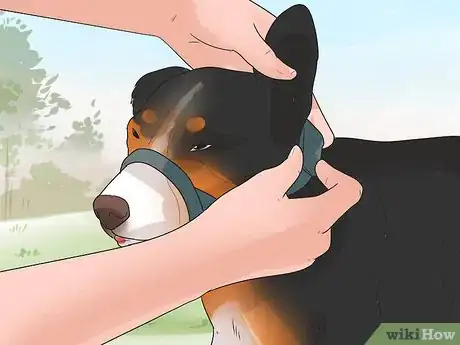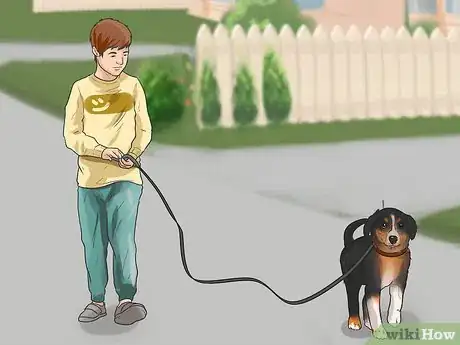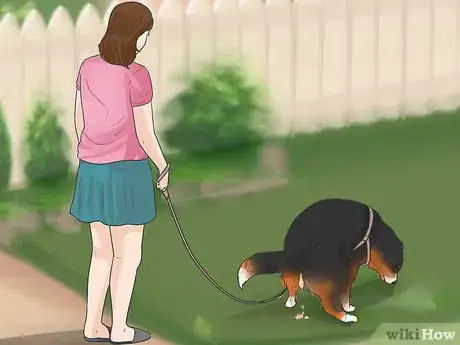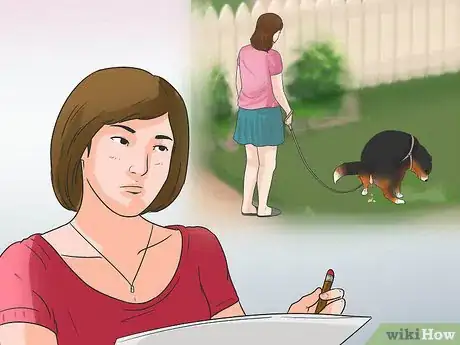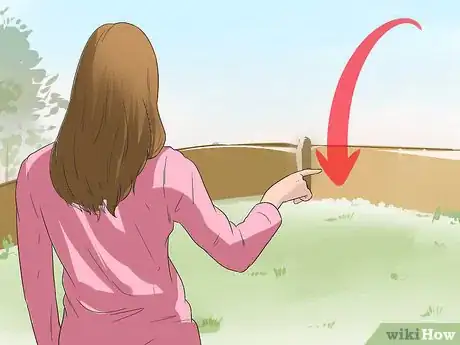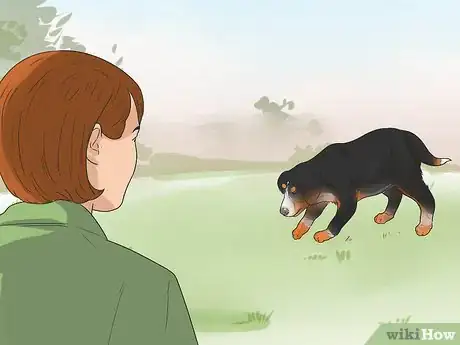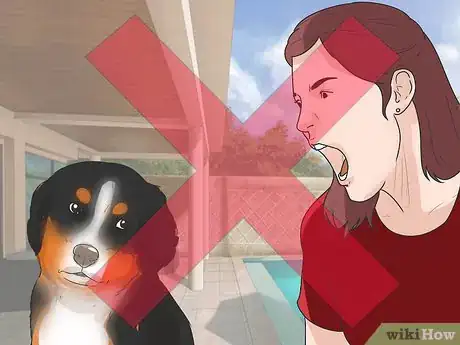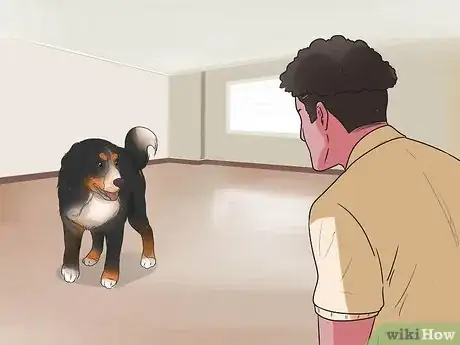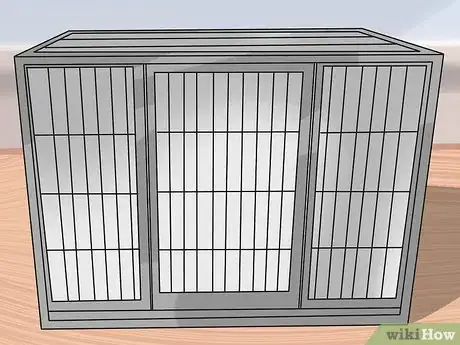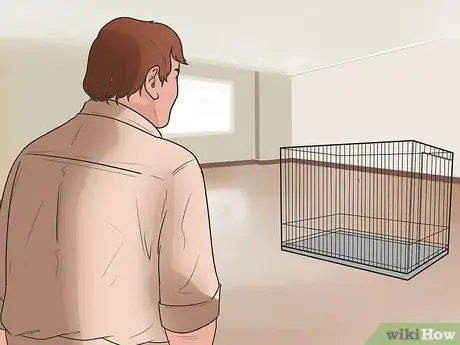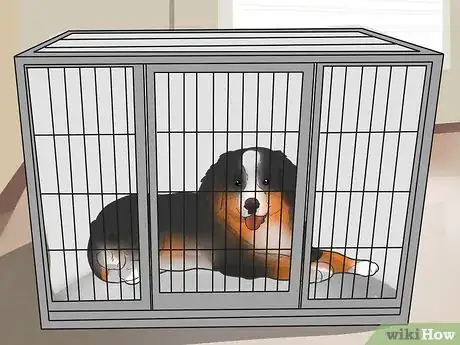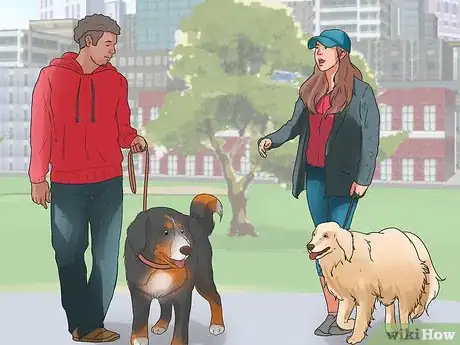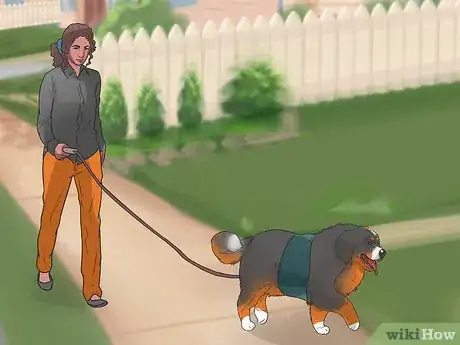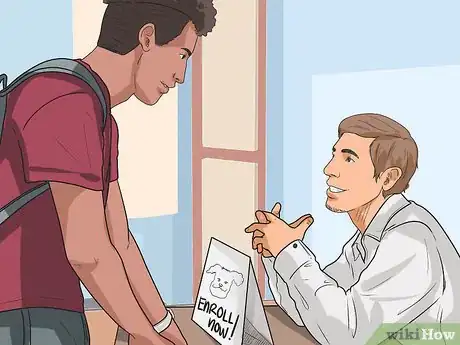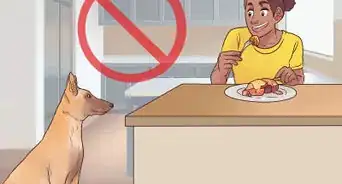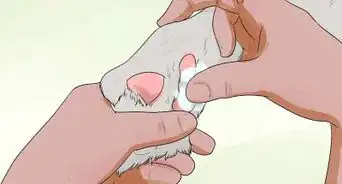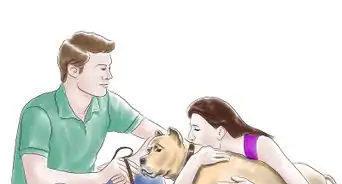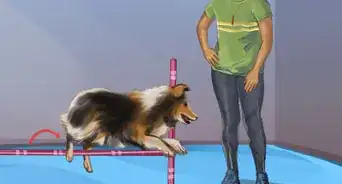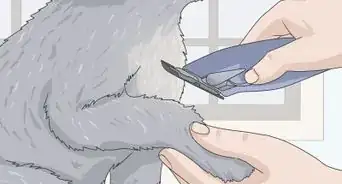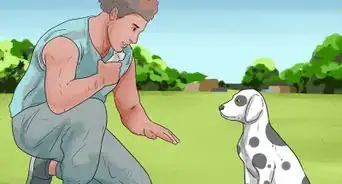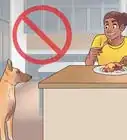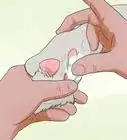This article was co-authored by Pippa Elliott, MRCVS. Dr. Elliott, BVMS, MRCVS is a veterinarian with over 30 years of experience in veterinary surgery and companion animal practice. She graduated from the University of Glasgow in 1987 with a degree in veterinary medicine and surgery. She has worked at the same animal clinic in her hometown for over 20 years.
There are 18 references cited in this article, which can be found at the bottom of the page.
This article has been viewed 79,279 times.
Training a Bernese Mountain Dog takes time, commitment, and plenty of patience. This breed is very large, so its very important to give your dog proper training from puppyhood to make sure he is a good canine citizen and a pleasure to be around. Before you even get your Bernese Mountain Dog, you will want to make sure you have the time to care for him and train him. Your puppy or dog wants to please you, so your job is to train him to understand you and your directions.
Steps
Understanding the Fundamentals
-
1Be patient. Never strike or yell at a puppy if she disobeys you. Bernese Mountain Dog tend to be very mild tempered and obedient but they, like all dogs, will take some time to train.[1] Hitting it will only make the puppy fear you and confuse her — never strike your dog. If you in the middle of a training session and she doesn't fully understand, do not become impatient and scold her. After all, the puppy or dog is only learning.
- If you find that you are losing your patience, step away from the dog and try again later.
- Bernese Mountain Dogs are extremely affectionate and want to please — scolding or punishing may have an extremely detrimental affect on your Bernese. Focus on positive reinforcement instead of punishment.
-
2Reward good behavior. This could be with a tiny tasty treat or just praise as the dog develops. If the dog knows he gets a treat for good behavior, and bad behavior is ignored, then he is likely to reproduce good behavior it was rewarded for.[2]
- When you catch your dog or puppy chewing or destroying something he shouldn’t, remove either the dog or the object from the dog and distract him with something it can “destroy” or chew on, like a toy. Then praise him for chewing on the right thing — the toy.
- Keep a bag of treats in a Ziploc bag in your pocket or in a “fanny” type bag at your waist. This means you will always have a treat handy. You never know when an opportunity to train will pop up during the day!
Advertisement -
3Keep training sessions short. During the first few weeks of training a puppy’s attention span is short, usually less than five minutes. As your puppy gets older and starts to associate training times with pleasant interaction with you, the training time can be increased.
- You will know the dog's attention span is increasing when the puppy focuses more on the training sessions than on wandering off and playing.
-
4Start training your dog immediately. You can teach your puppy commands from the moment she arrives home. Keep training sessions short (less than five minutes) and practice three to five times a day. [3]
- Your Bernese Mountain Dog should be able to learn a variety of commands. Start with leash etiquette and commands that limit bad behavior, and move on to more specific commands.
Teaching Commands to Your Bernese
-
1Teach the dog to stop bad behavior. It essential that you train your dog a command for when you want him to stop doing something. "Stop" or "leave it" are common commands — whichever you choose, make sure that you are consistent and that everyone in the household uses the same command. When you see your dog doing the unwanted behavior, first give the command, then immediately follow with action (taking away the item or moving your dog away from it). By giving the command first, then doing the corrective action, you will give your dog the opportunity to do what you want when he hears you say "leave it" and avoid an unpleasant consequence.[4]
-
2Train your dog to stop biting and chewing. Puppies explore their environment by mouthing everything in sight. While these are natural behaviors for a puppy, you also don't want her to think it's okay to bite people or chew on your shoes. Your dog will not know what is appropriate for her to chew unless you teach her.
- Keep anything you don't want your puppy to destroy up and out of her reach (this includes trash, books, shoes, remote controls, glasses, dirty underwear, etc.). Have plenty of toys for her to play with and chew on, but make sure they are not indistinguishable from household items (your dog will not know the difference between an old sock you offer her to play with and a new sock she is not supposed to chew).
- Allow your puppy to mouth you, so long as it is gentle. When your puppy gives you a hard bite, give a high-pitched yelp, as though she's really hurt you, and let your hand go limp (don't jerk it away). Your dog should stop biting, at which point you should praise her for stopping. If she bites you hard again, repeat these steps. Do this no more than three times in a 15-minute time period.[5]
- Give your dog a chew toy when she wants to chew on fingers.
- If you find your puppy chewing on something she shouldn't be, take it away and give her a toy to chew instead. As you take the item away, say “leave it” and give her a toy to chew on.[6]
- Do not punish your dog after the fact. If you find an item that your dog destroyed while you were away, don't wave it in her face while yelling at her. This won't teach her not to chew — she will not get the connection that you are angry about something she did two hours ago. Unless you catch her in the act, do not scold your dog.[7]
-
3Teach the dog to sit. Most dogs can learn this command quickly with little trouble. Start out by observing your dog — when you see that he is in the process of sitting on his own, say "sit" clearly and in a firm voice.[8] As soon as his butt touches the ground, praise him, pet him, and give him a treat. Do this every time you spy your dog about to sit.[9]
- Another method is to stand in front of your dog with a treat in your hand. Hold the treat centimeters above your dog's nose, then move the treat backwards, over his head, leading his nose. He should follow the treat with his nose and should sit down as he does this. Again, as soon as his butt hits the floor, give him the treat and praise him.[10]
- Once your dog has the motion down, say "sit" just before you begin to lead his nose back with the treat.[11]
-
4Teach your dog to not jump on people. Puppies jump to your attention or while playing. This may be cute when your Bernese is little, but they grow into huge dogs, and she may injure or scare people if she jumps when she is full grown. Teach her not to jump when she is a puppy to avoid problems later on. If your dog has already mastered "sit," this can make teaching her not to jump a lot easier. When she's in a situation in which she is likely to jump — meeting a new person, for instance, tell her instead to sit and reward her with your attention.[12]
- When you see your dog is going to jump up on you, turn your body away, deflecting her, avoiding eye contact, and saying nothing. She will get the message that, when she jumps on you, she gets no reward or attention. Once she stops jumping and calms down, praise her with lots of petting, attention, and scratching.[13]
-
5Train your dog to lay down. Once your Bernese knows how to sit, you can teach him the "down" command. Ask your dog to sit, then hold the treat in front of his nose. Lower the treat to the ground — he should follow with his nose, lowering his body; you can praise him as he moves toward the down position. When his belly touches the ground and he laying down, reward him with the treat and more praise. Once he is familiar with the movement, add the verbal command. "Down," "lay," or "drop" are common commands. Say it just before you begin bringing the treat down.[14]
- Eventually, with practice, your dog will make the association between the action and the word "down."
-
6Teach your dog to stay. This can be a difficult command to train, as your dog will naturally want to follow you around. Teach this command to your dog once she has learned to sit and lay down. Begin teaching your dog to stay when she is calm (try after a walk), in a familiar environment, and with few distractions. Keep these sessions short at first, as it will be a challenge for her to stay in the beginning.
- Stand in front of your dog and ask her to sit or lay down. If she remains in the position for a few seconds, quickly reward her with a treat. This signals that she is released from the position and may do something else.
- Repeat the process and wait a few seconds longer before rewarding your dog. If she breaks the stay before you have released her (by rewarding her with the treat), say "ah-ah!" And start over.
- Add the verbal command. When your dog is sitting or laying down, say "stay" and put one hand out like a stop sign. Wait a few seconds, then reward her with the treat. Gradually increase the length of the stay. Do this slowly, and don't make these training sessions too long or your dog may get frustrated.
- When your dog seems to be grasping stay, you'll need to complicate things a bit more. Because you want her to stay in position even when you are out of sight (if you ask her to sit and stay while you go in a store, for instance), begin taking a few steps back from your dog after commanding her to stay. If she breaks the stay, she does not get the treat.
- Some argue that this is not a necessary command — your dog should know that when you tell her to sit or stay, she should remain in that position until you release her.
-
7Teach the dog to come when called. The stay command is an important command for your dog's safety — it can stop him from dashing into a busy street or another dangerous situation. Never let your dog off the leash outside (in an unfenced area) until he knows the "come" and "stay" commands and does them consistently.[15] To practice this command, leash your dog and have some treats handy.
- Holding the end of the leash, say "come" in a very welcoming voice, then quickly take a few steps backwards. Continue to back up until your dog reaches you. Reward him by saying "Yes!," then give him a treat. You can also practice this off-leash. Crouch or kneel and call your dog over to you throughout the day, rewarding him greatly when he comes to you.
- Never punish your dog when he comes to you. This could mean giving him a bath or shouting at him for not coming when you called, or even just ending his fun by snapping his leash back on every single time he obeys. Coming to you when you call needs to be the most appealing option your dog knows — more appealing than chasing that rabbit or running across the street to say hi to the neighbor.[16]
- Your dog must understand that he must come every single time you call him. When you are training, don't put him in a situation in which you know he won't obey you and then try the come command.[17]
Leash Training Your Bernese
-
1Let your dog get comfortable with her collar and leash. Teaching your Bernese Mountain Dog proper leash etiquette is very important — a big dog like a Bernese could easily drag you down the street if she isn't trained. Start out by letting her get comfortable with her collar. Put it on when she's likely to be distracted, like when she's playing or eating food.[18]
- If she tries to scratch it off or remove the collar, do not allow her to do so. Do not remove the collar until she's forgotten about it.[19]
- Once your Bernese is used to wearing her collar, clip on a lightweight leash. Don't try to lead her or do anything with it — let her just drag it around the house (under your supervision) and sniff it.[20]
-
2Teach your dog to walk with a loose leash. Once your dog feels comfortable with his collar and leash, take the leash and begin walking around the house with him. If he walks beside you and/or lets the leash be loose or slack, give lots of praise, pats, and treats. If he begins to pull, stop in your tracks. Do not pull him back to you and do not proceed — allow him to come back to you. When the leash is loose again, praise him and begin walking again.[21]
- Never allow your puppy to pull you on the leash, as this teaches him that this is acceptable. By stopping the walk, he learns that pulling and straining will get him nowhere. If he wants to walk, he must do so without pulling.[22]
- If your puppy does the opposite and sits down, do not yank on the leash to get him to keep moving. Instead, call him over to you, offering treats and rewards when he comes.[23]
Potty Training Your Bernese
-
1Begin potty training immediately. Potty training, or house training, starts the moment your Bernese Mountain Dog sets foot in your house. When you first arrive at your home, let him sniff around the yard until he goes to the bathroom.[24]
- When the dog does urinate or defecate, give him lots of praise so he associates going to the bathroom outside with being praised.
-
2Set a routine. Take your puppy outside on a regular basis. Puppies, in particular, need to go to the bathroom quite frequently. They will not always give you a clear sign that they need to relieve themselves, so taking the dog outside on a regular basis will give the dog the chance to go to the bathroom when she needs to.[25]
- If you can really set a routine, your dog's digestive system will get used to the schedule and she will go to the bathroom like clockwork.
-
3Give your dog a specific spot to go to the bathroom outside your house. Have him go to the bathroom in one specific spot every time. This will solidify the fact that the dog needs to go to the bathroom outside if he has one spot that is his own spot.
-
4Watch the dog closely. When you’re inside your house with your puppy, watch her carefully for signs that she needs to go potty. Panting, pacing, sniffing around, or barking are all signs she needs to go outside to potty.
- Immediately rush your puppy outside and let her go to the bathroom. When she does, lavish her with praise as soon as she relieves herself.
-
5Don't punish a dog for accidents. If you fail to catch the dog's signal, and a potty accident occurs, don’t scold or hit the dog — he won't make the association that you are angry because he went to the bathroom in the wrong place. Instead, quietly clean up the mess and try again.
- Scolding the dog will only make the dog fearful and secretive when he goes to the bathroom. Your dog will go to the bathroom in places that are hard to spot.
Crate Training Your Bernese
-
1Begin by putting the dog in a isolated area. You will need to confine your puppy to a small space (bathroom, mud room, laundry room) with an easily cleaned floor if you can’t be with her or when she isn’t under your constant eyesight. Crate or kennel training your puppy is one of the best ways to potty train a dog. As an added bonus, it also gives the puppy a safe retreat when she needs a break from life in general.[26]
-
2Get a crate for your dog. You will need to purchase a crate that is appropriately sized to fit the size your dog will be as an adult.[27] Bernese Mountain Dogs are very large, so you will need to purchase a large crate. A crate that is about 60"x36" or 72"x36" should be large enough for your dog.[28] If your Bernese is hunched over or can't turn around comfortably in the crate, then you need to buy a bigger crate for him..
-
3Put the crate in a location your dog has access to at all times. The dog should have access to the crate at all times, as the goal is to make it a place the dog goes to when she needs a break. Put the crate in your living room or kitchen with the door open and crate pad or a blanket inside.
-
4Gradually increase the amount of time the puppy is in the crate. Encourage the puppy to go into the crate on her own by tossing a treat or toy inside. Do this throughout the day for a few days, always leaving the door open. Once she is comfortable inside the crate, close the door after she goes in. Allow her to come out of the crate only after she has been quiet for 10 minutes — do not let her out if she is whining or pawing at the door.
- Increase the amount of time the puppy spends in the crate until she is able to stay quietly in the crate for up to two hours. When she is older than four months, she can stay in the crate for up to four hours.
- Never leave your dog in a crate for longer that four hours (or two hours if she is under four months old).
- Never use the crate as punishment. The crate is meant to be your puppy's safe haven, not somewhere she goes when she's been bad.
Socializing Your Bernese
-
1Begin socializing early. Dog socialization means learning to be a part of human and dog society in a healthy manner. Bernese Mountain Dogs are known to be a little aloof, so socializing in the first year of life is especially important.[29] While it’s an important part of any puppy’s training, for a giant breed of dog it’s imperative.
- Begin by introducing the dog to normal household noises and activity in a non-threatening manner. Don’t tease your puppy by chasing it with a broom or vacuum. This will only make it fear these things and maybe even you.[30]
-
2Take your puppy out into the world. Take your puppy for car rides to get it used to riding in vehicles and to introduce them to street sights and sounds through the windows. Dog parks (with your puppy safely leashed) are another good way to interact with other dogs and humans.
- Puppies can be brought to these places after they have had their first two distemper vaccines. Do not let your puppy off leash unless you are certain it will get along with other dogs and humans.[31]
-
3Enroll in a socialization or obedience class. One of the most productive ways to introduce a puppy to other puppies, humans, and normal sights and sounds is to take them to puppy socialization or obedience classes (for older dogs). These classes are held by community education, 4-H clubs, or pet shops and give the dogs and owners a safe place to learn together.
- Look through your local newspaper or on-line to find classes near you. Your veterinarian’s office may also know of any classes available.[32]
Expert Q&A
Did you know you can get expert answers for this article?
Unlock expert answers by supporting wikiHow
-
QuestionCan Bernese Mountain Dogs live outside?
 Pippa Elliott, MRCVSDr. Elliott, BVMS, MRCVS is a veterinarian with over 30 years of experience in veterinary surgery and companion animal practice. She graduated from the University of Glasgow in 1987 with a degree in veterinary medicine and surgery. She has worked at the same animal clinic in her hometown for over 20 years.
Pippa Elliott, MRCVSDr. Elliott, BVMS, MRCVS is a veterinarian with over 30 years of experience in veterinary surgery and companion animal practice. She graduated from the University of Glasgow in 1987 with a degree in veterinary medicine and surgery. She has worked at the same animal clinic in her hometown for over 20 years.
Veterinarian Bernese Mountain Dogs originate in the snowy Swiss Alps. You would think this equips them for life outdoors. However, few modern dogs have seen the Alps and may not be naturally attuned to outdoor life. With care, you could acclimatize this breed to living outside, but they may struggle in extreme heat or cold.
Bernese Mountain Dogs originate in the snowy Swiss Alps. You would think this equips them for life outdoors. However, few modern dogs have seen the Alps and may not be naturally attuned to outdoor life. With care, you could acclimatize this breed to living outside, but they may struggle in extreme heat or cold. -
QuestionAre Bernese Mountain Dogs easy to train?
 Pippa Elliott, MRCVSDr. Elliott, BVMS, MRCVS is a veterinarian with over 30 years of experience in veterinary surgery and companion animal practice. She graduated from the University of Glasgow in 1987 with a degree in veterinary medicine and surgery. She has worked at the same animal clinic in her hometown for over 20 years.
Pippa Elliott, MRCVSDr. Elliott, BVMS, MRCVS is a veterinarian with over 30 years of experience in veterinary surgery and companion animal practice. She graduated from the University of Glasgow in 1987 with a degree in veterinary medicine and surgery. She has worked at the same animal clinic in her hometown for over 20 years.
Veterinarian
References
- ↑ http://www.akc.org/dog-breeds/bernese-mountain-dog/care/
- ↑ https://sites.psu.edu/siowfa15/2015/09/18/the-science-behind-giving-dogs-treats-positive-reinforcement/
- ↑ https://vetmed.tamu.edu/news/pet-talk/training-tips-for-dogs
- ↑ http://www.training-your-dog-and-you.com/no-command.html
- ↑ http://www.aspca.org/pet-care/dog-care/common-dog-behavior-issues/mouthing-nipping-and-play-biting-adult-dogs
- ↑ Canine and Feline Behavior for Veterinary Technicians and Nurses. Edited by Julie Shaw and Debbie Martin. John Wiley & Sons, Inc. 2015
- ↑ http://www.humanesociety.org/animals/dogs/tips/destructive_chewing.html
- ↑ http://www.dog-obedience-training-review.com/training-your-dog-to-sit.html
- ↑ http://www.dog-obedience-training-review.com/training-your-dog-to-sit.html
- ↑ http://www.dog-obedience-training-review.com/training-your-dog-to-sit.html
- ↑ http://www.dog-obedience-training-review.com/training-your-dog-to-sit.html
- ↑ http://www.dog-obedience-training-review.com/jumping-up.html
- ↑ http://www.dog-obedience-training-review.com/jumping-up.html
- ↑ http://www.dog-obedience-training-review.com/training-a-puppy-to-walk-on-a-leash.html
- ↑ Handbook of Applied Dog Behavior and Training, Procedures and Protocols. Volume 3. Steven R. Lindsay. Blackwell Publishing. 2005
- ↑ http://www.dog-obedience-training-review.com/dog-training-come.html
- ↑ http://www.dog-obedience-training-review.com/dog-training-come.html
- ↑ http://www.dog-obedience-training-review.com/training-a-puppy-to-walk-on-a-leash.html
- ↑ http://www.dog-obedience-training-review.com/training-a-puppy-to-walk-on-a-leash.html
- ↑ http://www.dog-obedience-training-review.com/training-a-puppy-to-walk-on-a-leash.html
- ↑ http://www.dog-obedience-training-review.com/training-a-puppy-to-walk-on-a-leash.html
- ↑ http://www.dog-obedience-training-review.com/training-a-puppy-to-walk-on-a-leash.html
- ↑ http://www.dog-obedience-training-review.com/training-a-puppy-to-walk-on-a-leash.html
- ↑ https://www.cesarsway.com/dog-training/housebreaking-issues/housebreaking
- ↑ https://www.cesarsway.com/dog-training/housebreaking-issues/housebreaking
- ↑ http://iml.jou.ufl.edu/projects/fall09/piquet_m/training.html
- ↑ http://www.humanesociety.org/animals/dogs/tips/crate_training.html
- ↑ https://apdt.com/resource-center/choosing-right-crate-size/
- ↑ http://www.bmdca.org/breed_education/pdf/01_bernese_basics_about.pdf
- ↑ Blackwell's Five-Minute Veterinary Practice Management Consult. Lowell Ackerman. John Wiley & Sons. 2006
- ↑ Blackwell's Five-Minute Veterinary Practice Management Consult. Lowell Ackerman. John Wiley & Sons. 2006
- ↑ Blackwell's Five-Minute Veterinary Practice Management Consult. Lowell Ackerman. John Wiley & Sons. 2006
About This Article
To train a Bernese Mountain Dog, work with it in short, 5 minute training sessions before gradually increasing the time you spend teaching it commands. In the beginning, try to keep a few treats in your pocket so that you can reward your dog when it does something good. If it does something naughty, like chewing on furniture or jumping up on you, say “Stop,” firmly and remove it from the situation. You should avoid yelling at your dog so that it doesn't become afraid of you. For advice from our Veterinary co-author on how to crate train your Bernese Mountain Dog, read on!
